How to Treat and Prevent Runner's Rash
Runner’s rash is a common skin condition that affects the thigh, groin, buttocks, lower leg, and sometimes the armpit. It can be caused by many factors, but the most common are friction, heat and moisture.
Runner’s rash may affect your performance so it’s key to prevent it from happening in the first place and treat it if you already have it.
In this article, we are going to share with you exactly how to treat it and tips to prevent it from hindering your workout.
Let’s get started.
What is runner’s rash?

Runner's rash is a type of skin irritation that is caused by sweat, heat, and chafing. It usually appears on the thighs and around the groin area.
A runner's rash may not seem like a big deal at first, but minor chafing can be quite painful if you ignore it. And this may affect your performance.
The good news is you can reduce your chances of getting a running rash by using anti-chafing products.
What causes runner’s rash?
It's common for your skin to become hot and sweaty when you run. Heat rash occurs when sweat glands become blocked, trapping sweat below the skin.
This is an ideal scenario for a runner's rash to develop. Your chances of getting this condition are higher if you wear clothing that's too tight.
Runner's rash can be treated with a few simple steps. However, it is important to remember that runner's rash can only be prevented if you take precautionary measures to avoid it in the first place.
How to prevent runner’s rash

Runner's rash can only be prevented if you take precautionary measures to avoid it in the first place. Here are some tips to make sure you never have to deal with runner’s rash:
- Apply a product specifically designed for lubricating high-friction areas to prevent chafing. Trihard’s Anti-Chafing Roll-On provides an anti-chafing barrier to reduce friction. It helps hydrate, lubricate, and soothe the skin. It absorbs and dries quickly creating a hands-free, clean, and smooth application experience.
- Use the right clothing. Choose loose clothing with plenty of airflow. Make sure your clothes don’t allow any skin-to-skin contact as you run, since it can also lead to chafing.
- You should avoid fabrics such as denim and cotton, as they tend to absorb moisture easily and are heavier. Make sure you wear fabrics that draw sweat away from your skin.
- Being well hydrated is essential to minimizing the risk of chafing. Dehydration interferes with your body's ability to drain salts from your skin. Drink plenty of water to prevent sweat from drying up and forming salt crystals that clog your pores.
How to treat runner’s rash

It’s crucial to take action as soon as you notice symptoms of chafing to recover faster. Here are some things you should do:
- Dry the affected area, apply a lubricant, or change your clothes when you experience chafing during exercise.
- If you sweat, wash your skin immediately afterwards to remove salt residue. Use soap to gently clean the area.
- Apply a moisturizing lotion to the affected area. Use an anti-chafing product like Trihard’s Anti-Chafing Roll-On to alleviate any skin discomfort you may feel.
- Make sure your clothes do not irritate or rub the area. Allow the affected area to air.
- To allow the injured area to heal, you may need to take a few days off from the activity that caused the chafing.
- In the event that your symptoms persist or the affected area does not improve, consult a doctor or medical expert.
Summary
Runner's rash is a type of skin irritation caused by sweat, heat, and chafing. It can be quite painful if you ignore it, but using anti-chafing products can help.
Runner's rash develops when sweat glands become blocked, and your chances are higher if you wear clothing that's too tight.
Runner's rash can be prevented by applying a product specifically designed for lubricating high-friction areas. This product helps hydrate, lubricate, and soothe the skin.
Use the right clothing to avoid chafing while running. Choose loose clothing with plenty of airflow and avoid fabrics such as denim and cotton.
To treat runner's rash, you should dry the affected area, apply a lubricant, or change your clothes as soon as you notice symptoms of chafing. Allow the affected area to air and take a few days off from the activity that caused the chafing.






























Leave a comment